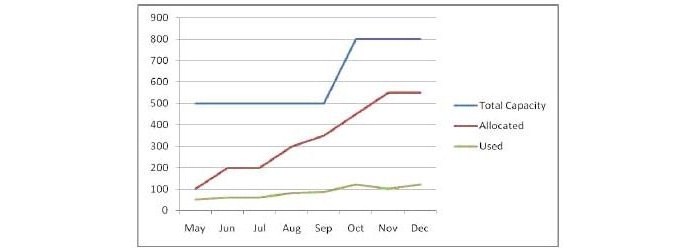Capacity Planning in Cloud
 Recently, I was asked if a company uses public clouds still need to do capacity planning, since, in theory, the computational resources available would be inexhaustible. When you need more resources, said the person, just ask your provider the provisioning of the cloud.
Recently, I was asked if a company uses public clouds still need to do capacity planning, since, in theory, the computational resources available would be inexhaustible. When you need more resources, said the person, just ask your provider the provisioning of the cloud.
But let’s think a bit. Let’s imagine that a cloud provider or as a utility company, such as a mobile carrier. In theory, just go to a store and buy a carrier line. True, but every now and then are unpleasantly surprised by problems of overload, which causes us many problems, failures or interruptions in connection. Not always possible to maintain the capacity greater than demand. There are times and places where demand is greater than capacity.
We return to the cloud providers who has to make a large investment to build the data center and obviously need to recover their investments and drive profitability. It may happen that in certain situations the provider does not have sufficient capacity to accommodate more applications and maintain the same level of service. To always guarantee an instant service the provider would care to hold a capacity in excess (over provisioning), which I admit, is quite costly. In practice it will probably operate other service providers, that is to sell more than the capacity supported, hoping that not all requirements are simultaneously. Who does this constantly are airlines, with its practice of overbooking.
There is an aggravating factor. Computational resources such as servers and storage can be quickly acquired by the provider to meet growing demands, but the bandwidth of the network takes much longer to be expanded. It is a potential bottleneck.
So the resources are not infinite. Providers need to do capacity planning studies to determine what capacity they can offer to the market. What about users? Well, the company that will use public clouds must estimate how much resources are needed, including to do the math on how much they must pay. The cost for virtual server is cheap, but the cost of transmitting data tend to be far more expensive.
Moreover, as the models of cloud services evolve, new ways to pay arise and capacity planning helps identify what the best option. It is not hard to imagine the future we see the market for cloud providers offering public resources with different prices, according to the time of day or month.
Is that a bottom line?
Capacity planning is still needed. When using a public cloud you do not study to acquire physical computers, but should plan on computational resources demand and how these cost estimating virtual resources. And if it’s worth paying for them or not…
- How Cloud Computing Is Changing The Labor Market - March 25, 2015
- Adopting Infrastructure as a Service Can be a Good Deal - March 17, 2015
- Will Virtualize? Take These Six Points Into Consideration - March 12, 2015